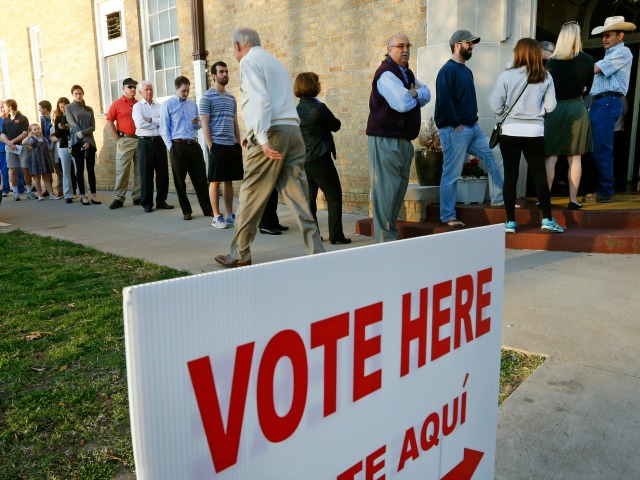Newly compiled data after the New York Republican primary shows that among the states that have voted so far in 2016, GOP primary and caucus turnout is up well more than 8 million votes and well more than 60 percent over 2012’s process.
Top GOP officials say that the intense interest in the GOP primary throughout the year so far only serves to benefit the Republican nominee in November, whoever it ends up being.
In total, so far, nationwide the GOP has seen an increase of 8,719,041 votes in 2016’s primaries, caucuses and conventions over 2012’s primaries, caucuses and conventions. In 2012, 14,452,500 people voted in each of the states and territories that have held contests so far in 2016. In 2016, 23,171,541 people have voted in the GOP contests so far. That is a 60.33 percent increase in GOP contest turnout in just four years.
Republican National Committee chairman Reince Priebus reacted to the news in an exclusive comment to Breitbart News saying that voters are flocking to the GOP after a bad past eight years with Democratic President Barack Obama because they know Democrat Hillary Clinton as president would be “disastrous.”
“After eight years of Barack Obama, voters throughout the country know that four years of Hillary Clinton would be disastrous,” Priebus said in an email. “Almost to a state, we are seeing record turnout because voters know it’s the Republican Party that has the ideas and solutions that will move America in the right direction.”
So far in 2016, 38 separate U.S. states and territories have held contests—whether they be caucuses or primaries—and with the exception of six of them turnout is much higher this year than in 2012. The only six contests where turnout has dropped are Wyoming, Utah, Washington, D.C., Puerto Rico, the Northern Mariana Islands and the U.S. Virgin Islands.
Three of those are U.S. territories and therefore have no electoral votes in the general election in November and the fourth is the U.S. capital city has just three electoral votes in the general election contest. The two only U.S. States that has seen a drop in GOP turnout, therefore, are Utah and Wyoming—both of which are reliably Republican states.
D.C. switched from a primary in 2012 to a convention in 2016. Utah switched from a primary in 2012 to a caucus in 2016. The Northern Mariana and U.S. Virgin Islands systems are caucuses. Caucuses and conventions tend, in politics, to lower turnout from primary elections—which generally increase turnout because it’s easier to register and vote. Wyoming’s convention system, which has been around for years, is confusing and generally dominated by activists heavily involved in the party on a local level, not the general voting public. Colorado, which technically didn’t have any voters involved in their convention system this year, also saw a drop off in participation.
Otherwise, though, everywhere else the GOP voter involvement is on the rise. Every other state that has voted so far has seen an increase in GOP turnout in the primaries, and in some cases a substantial turnout spike. The states that have seen an increase are: Alabama, Alaska, Arizona, Arkansas, Georgia, Hawaii, Idaho, Illinois, Iowa, Kansas, Kentucky, Louisiana, Maine, Massachusetts, Michigan, Minnesota, Mississippi, Missouri, Nevada, New Hampshire, New York, North Carolina, Ohio, Oklahoma, South Carolina, Tennessee, Texas, Vermont, Virginia and Wisconsin.
Some of these states have seen drastic increases in voter participation in GOP contests. Arkansas saw a 169.7 percent increase, while Idaho—which went from a caucus in 2012 to a primary in 2016—saw a 396.96 percent increase. Missouri saw a 272.45 percent increase and New York saw a 354.96 percent increase while Virginia saw a 286.13 percent spike.
Breitbart News compiled this data analysis from information purchased from Dave Leip’s Atlas of U.S. Presidential Elections. That data, available at USElectionAtlas.org, is widely used by academics and media organizations including the New York Times, the Economist, Harvard, Columbia, Cornell, and many more reputable organizations.
More from Breitbart News’ data analysis on this election is forthcoming.
LISTEN TO MATTHEW BOYLE ON BREITBART NEWS DAILY ON SIRIUSXM:


COMMENTS
Please let us know if you're having issues with commenting.